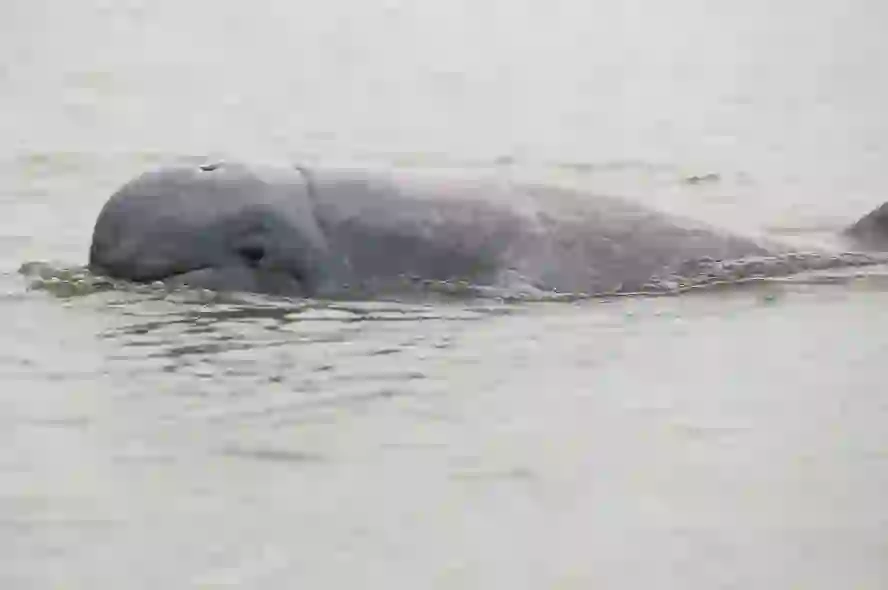
Irrawaddy Dolphin
Irrawaddy Dolphin
Irrawaddy Dolphin
In the rivers and seas of Southeast Asia, there lives a unique dolphin with a round head and no dorsal fin. Its name is the Irrawaddy dolphin. Known for their cooperative fishing with humans, these dolphins are truly remarkable. Let's delve into the fascinating ecology of the Irrawaddy dolphin and the threats they face.
Irrawaddy Dolphin Basic Infomation

| Property | Value |
|---|---|
| Scientific Name | Orcaella brevirostris |
| Taxonomic Status | ACCEPTED |
| Rank | SPECIES |
| Vernacular Names | Irrawaddy Dolphin |
| Kingdom | Animalia |
| Phylum | Chordata |
| Class | Mammalia |
| Order | Cetartiodactyla |
| Family | Delphinidae |
| Genus | Orcaella |
| Habitats | Rivers, coasts, and estuaries of Southeast Asia and northern Australia |
| Conservation Status | Endangered |

Size
They are about 7.5 feet (2.3 meters) long and weigh about 286 pounds (130 kilograms). They are relatively small among dolphins. Females are slightly larger than males.

Lifespan
Their lifespan in the wild is estimated to be about 30 years.

Distribution
They live in rivers, coastal waters, and estuaries of Southeast Asia and northern Australia. They are particularly common in the Irrawaddy River in Myanmar, the Mekong River, the Mahakam River, and around the island of Malapascua in the Philippines. They prefer brackish water, where freshwater and saltwater mix.
Irrawaddy Dolphin Q&A

What kind of dolphin is the Irrawaddy dolphin?
The Irrawaddy dolphin is a species of dolphin belonging to the genus Orcaella.
They are characterized by their round head, short beak, and lack of a dorsal fin. They have a grayish body color with a slightly lighter belly. They are found in the rivers, coasts, and estuaries of Southeast Asia and northern Australia, feeding on fish, crustaceans, and cephalopods. They may be solitary, but are often found in groups of a few to several dozen individuals. They are highly intelligent and are said to be capable of communicating with humans. They are also known for their cooperative fishing behavior, working with fishermen to herd fish into nets. This is thought to be because they know they will get a share of the catch from the fishermen. It's a fascinating example of symbiosis between humans and animals!

What do Irrawaddy dolphins eat?
Irrawaddy dolphins are carnivores, primarily feeding on fish, shrimp, crabs, and other crustaceans.
They swim along the shallow seabed, foraging for food. They also use echolocation to find their prey. By emitting sound waves, they can understand their surroundings and pinpoint the location of their prey. This ability allows them to hunt efficiently, even in murky water.

[Quiz!] Why are Irrawaddy dolphins endangered?
The Irrawaddy dolphin is listed as 'Endangered' on the IUCN (International Union for Conservation of Nature) Red List.
Their numbers are declining due to various human activities:
・Bycatch from fisheries: They can get caught accidentally in fishing nets.
・Marine pollution: Industrial wastewater, sewage, and ship emissions pollute their habitats and reduce their food sources.
・Habitat destruction: Coastal development and dam construction are destroying their habitats.
・Noise pollution: Noise from boat engines and sonar interferes with their communication and causes them stress.
To protect Irrawaddy dolphins, we need to implement fishing regulations, control pollution, conserve their habitats, and reduce noise pollution.

[Quiz!] What efforts are being made to protect Irrawaddy dolphins?
Various efforts are being made to protect Irrawaddy dolphins:
・Fishing regulations: Improving fishing gear and practices, and setting catch limits to prevent accidental capture of dolphins in fishing nets (bycatch).
・Marine pollution control: Implementing various measures to prevent marine pollution caused by industrial wastewater, sewage, and ship emissions.
・Habitat protection: Establishing marine protected areas and regulating development to protect the coastal waters and rivers where Irrawaddy dolphins live.
・Public awareness campaigns: Raising awareness about the current situation of Irrawaddy dolphins and the importance of conservation.
・Promoting ecotourism: Organizing tours to observe Irrawaddy dolphins, generating income for dolphin conservation efforts and raising global awareness about their plight.
・International cooperation: Because Irrawaddy dolphins are distributed across several countries, international cooperation is essential for their conservation.
These efforts have led to a gradual increase in the Irrawaddy dolphin population. However, they are not out of danger yet. The future of these dolphins depends on the understanding and cooperation of each and every one of us.

Would you like to become a part of the 'Animalbook.jp'?
Turn your knowledge into Q&A and share it with the world. ※Publication will be activated after purchase. Let's share information together!
Irrawaddy Dolphin Type of List

Characteristics of Irrawaddy Dolphins
- Round head and short beak
- Lack a dorsal fin
- Grayish body color
- Slightly lighter belly
- Live in rivers, coastal waters, and estuaries of Southeast Asia and northern Australia
- Eat fish, crustaceans, and cephalopods
- Sometimes cooperate with fishermen to fish
- Endangered (EN)
Information
Congratulations! You are the first commenter!

Create Your Favorite List!
Irrawaddy Dolphin
Save the animals you love! Build your own list to quickly revisit your favorites later.

Would you like to leave a comment?
※Please note: This is for the purchase of rights to post comments within the article.
Find Your Favorites!
Our shop offers a unique and attractive selection of goods themed around various animals.
Irrawaddy Dolphin References
Irrawaddy Dolphin Introduction of media used

Foto: Stefan Brending

Help Enrich Our Animalbook.jp with Your Media!
We are constantly looking to expand and enrich our Animalbook.jp with amazing photos and videos of animals. If you have any media that you'd like to share, please contribute and help us showcase the beauty and diversity of the animal kingdom. Your submissions will be credited and featured in our encyclopedia, reaching a wide audience of animal lovers.


















